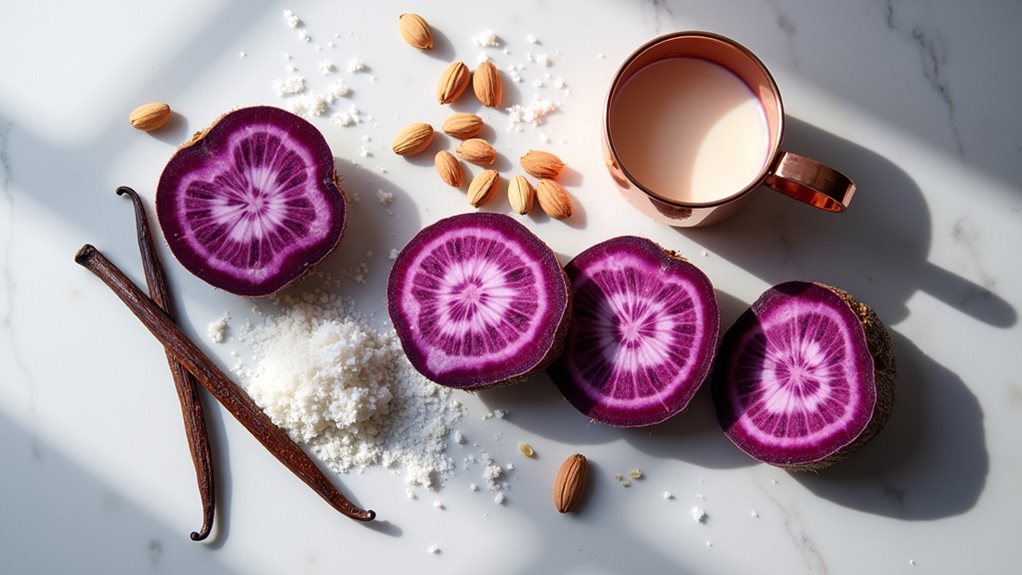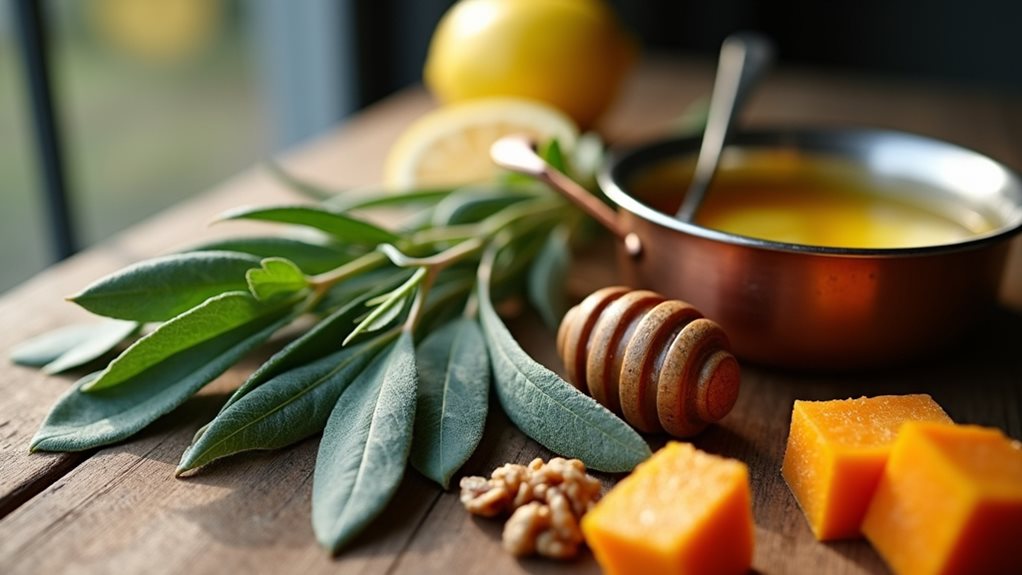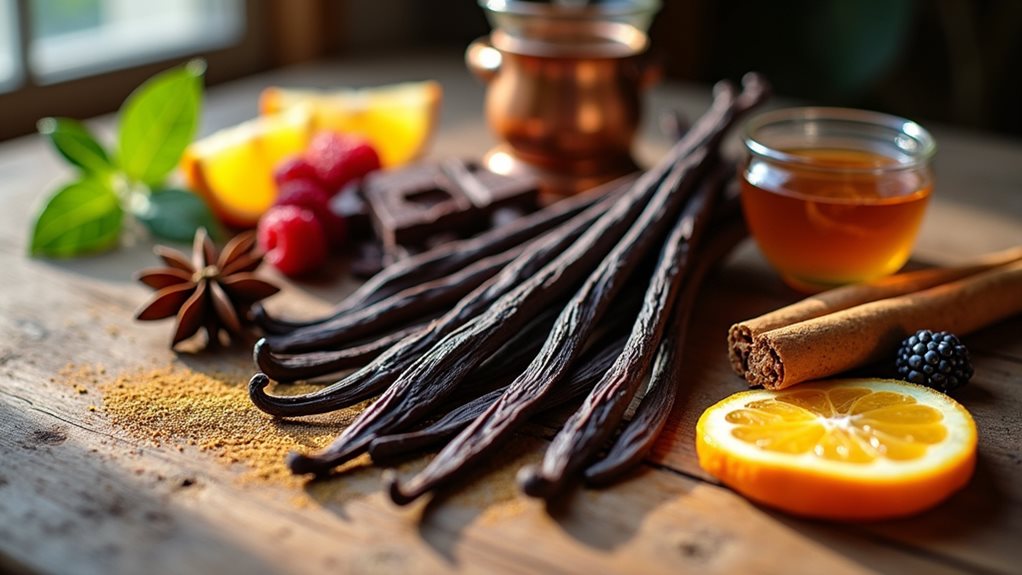Ube pairs wonderfully with coconut milk, condensed milk, and cheese to create classic Filipino flavor combinations. You'll find its sweet, nutty profile enhanced by butter for creaminess and salt to amplify sweetness. Try incorporating ube into sweet rice desserts like biko, or blend it into beverages with tapioca pearls and fresh fruits like mango. For innovative pairings, experiment with salted caramel, pecans, or global inspirations like Japanese mochi and Italian cannoli. Discover how this versatile purple ingredient transforms everyday dishes into extraordinary creations.
The Science Behind Ube's Unique Flavor Profile
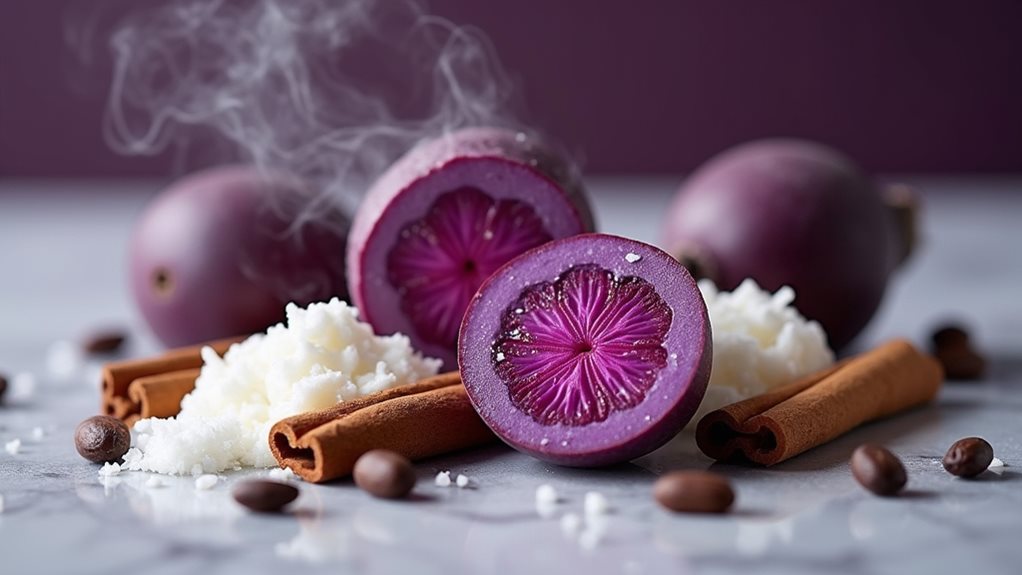
When you bite into an ube-flavored dessert, you're experiencing a complex interplay of compounds that create its distinctive taste. Anthocyanins, the same compounds responsible for ube's vibrant purple hue, contribute greatly to its ube flavor chemistry. These natural antioxidants work alongside starch, fiber, and subtle vanilla-like compounds to create that signature sweet, nutty, and earthy profile you've come to love.
Understanding ube taste profile means recognizing how its natural compounds interact with other ingredients. When you pair ube with butter, the fat molecules enhance its inherent creaminess. Ube's naturally sweet taste makes it highly versatile and suitable for a wide variety of culinary applications. Nutritionally, ube provides valuable dietary fiber that can enhance the mouthfeel of various desserts.
Add a touch of salt, and you'll notice how it amplifies the tuber's natural sweetness. This chemistry explains why ube works so beautifully with coconut—their similar sweet undertones create a harmonious flavor marriage.
Traditional Filipino Pairings for Ube
When exploring traditional Filipino ube pairings, you'll find that coconut and leche (condensed milk) create the most iconic combinations, adding creamy richness to the earthy purple yam.
Ube also shines when incorporated into sweet rice desserts like biko and kalamay, where the glutinous texture complements its distinctive flavor profile. Many recipes utilize latik as topping, adding a crispy coconut element that enhances the overall eating experience.
The balance of salty and sweet elements, particularly the popular combination of ube with cheese, demonstrates the Filipino culinary genius in creating contrasting yet harmonious flavor experiences. The vanilla-like notes in ube make it particularly versatile in various dessert applications, explaining its popularity beyond traditional Filipino cuisine.
Coconut and Leche
The marriage of ube with coconut and leche (milk) forms the backbone of traditional Filipino dessert culture, creating some of the most beloved sweet combinations in Southeast Asian cuisine.
You'll find coconut desserts like Ube Halaya using coconut milk to enhance the purple yam's nutty sweetness while adding luxurious creaminess to the final texture. Many home chefs prefer using coconut evaporated milk for its concentrated flavor when preparing ube-based treats. Ube's mild, sweet flavor perfectly complements the richness of coconut, creating a balanced taste profile that isn't overpowering.
For an indulgent treat, try Ube Leche Flan, which layers caramelized sugar with a smooth custard infused with ube's distinctive flavor.
The contrasting textures—silky flan against earthy ube—create a compelling sensory experience. This pairing isn't just delicious; it's visually striking, as the vibrant purple ube creates dramatic contrast against creamy white coconut or golden leche flan.
These combinations work equally well in traditional desserts or contemporary beverages like ube lattes.
Sweet Rice Combinations
Sweet rice forms the foundational canvas for some of ube's most iconic Filipino pairings, creating desserts that balance chewy texture with vibrant purple sweetness.
In traditional Ube Biko, you'll find glutinous rice mixed with ube halaya, coconut milk, and sugar, often topped with crispy latik for textural contrast. This classic combination showcases how sweet rice enhances ube's nutty profile while providing a satisfying chewiness. This beloved dessert can be easily preserved in an airtight container in the refrigerator for up to three days.
For innovative flavor combinations, try incorporating pandan leaves for aromatic complexity or a touch of vanilla to amplify ube's natural sweetness. Using ube condensed milk instead of ube halaya provides a richer taste while being more accessible for home cooks. You can also experiment with matcha powder for a striking visual and flavor contrast against the purple backdrop.
When preparing these sweet rice combinations, banana leaves offer both an authentic presentation and subtle aroma that elevates the entire dessert experience.
Salty-Sweet Balance
Traditional Filipino cuisine masterfully balances salty and sweet elements in ube-based desserts, creating flavor profiles that showcase both the purple yam's inherent sweetness and complementary savory notes.
You'll find this balance exemplified in classics like ube halaya paired with cheese in pandesal, where the savory cheese cuts through the jam's sweetness.
For a contemporary twist on this balance, try ube ice cream topped with salted pecans, which provides textural contrast while enhancing the yam's nutty undertones. The subtle earthy flavor of ube resembles a mix of vanilla and pistachio but with its own distinctive character.
Another winning combination is ube cheesecake drizzled with salted caramel, where the sauce's complexity amplifies the dessert's richness.
Even simple ube cookies benefit from a sprinkle of flaky sea salt, which elevates the purple yam's subtle flavor profile and prevents cloying sweetness. These cookies can be further enhanced by pairing them with tropical fruits like mango that complement ube's unique taste.
Sweet Combinations: Dessert Flavors That Complement Ube
When exploring the world of ube desserts, you'll discover an array of complementary flavors that enhance this purple yam's naturally nutty and sweet profile. The creamy texture of ube creates perfect flavor contrasts when paired with tropical fruits like mango, guava, and orange, which add brightness to its earthy undertones.
For richer dessert textures, combine ube with vanilla, toasted nuts, or coconut. These pairings create multi-dimensional experiences that will elevate your creations beyond the ordinary. Try incorporating sweetened condensed milk or buttercream in your ube cupcakes or cheesecakes for added indulgence.
Traditional Filipino desserts showcase ube's versatility—from the smooth consistency of Ube Halaya to the chewy delight of Ube Mochi Cake. Each combination offers a unique way to highlight this distinctive ingredient.
Beverages Enhanced With Ube's Purple Magic
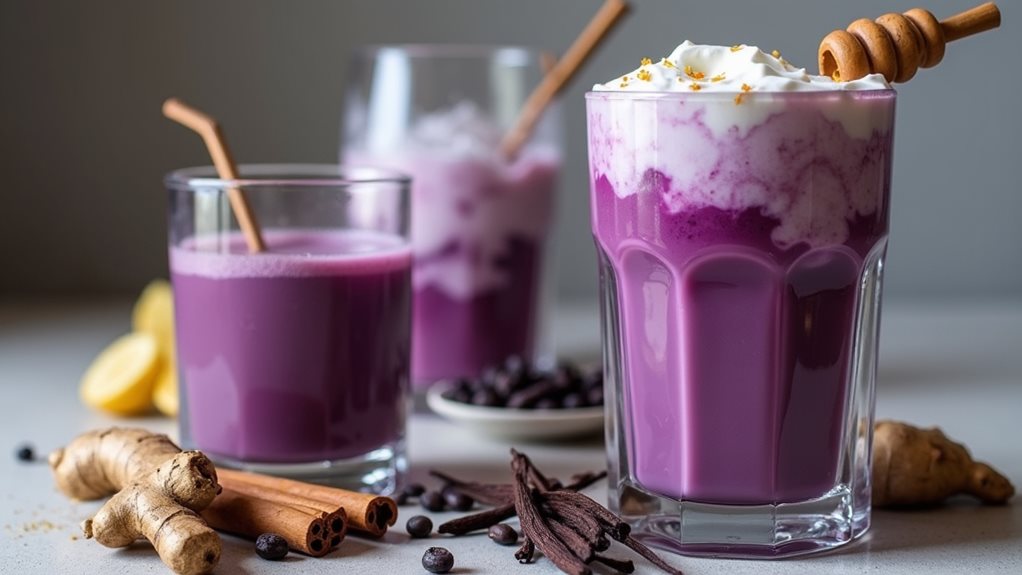
Ube's vivid purple color and distinctive flavor can transform ordinary beverages into eye-catching, flavorful experiences worthy of your next Instagram post.
You'll find ube creates magical milk teas with boba pearls, pairs surprisingly well with coffee's robust notes in lattes and cold brews, and blends perfectly with coconut milk for tropical smoothies that balance sweetness and nuttiness.
These purple-hued drinks offer not just visual appeal but also ube's unique taste profile, which complements both warm and cold beverage applications across various cultural traditions.
Ube Milk Tea Magic
The vibrant purple hue and uniquely sweet, nutty flavor of ube have transformed ordinary milk tea into an Instagram-worthy sensation that delights both the eyes and taste buds.
You'll find endless possibilities when crafting your own ube milk tea magic at home. Start with your preferred ube form—whether frozen, fresh, powdered, or extract—then pair it with your choice of milk (coconut milk creates an especially luxurious texture).
For extra indulgence, swirl in sweetened condensed milk or honey, and don't forget the textural elements that make milk tea special: chewy tapioca pearls, popping boba, or a dollop of whipped cream.
Consider blending with ice for invigorating summer drinks, or heating your mixture slowly on the stovetop for a comforting warm beverage. The versatility of ube guarantees your creation will be uniquely yours.
Coffee's Purple Partner
Coffee enthusiasts seeking a vibrant twist for their morning brew have discovered an unexpected ally in ube, the purple yam that transforms ordinary beverages into extraordinary experiences.
This Filipino favorite brings its sweet, nutty profile to coffee pairings while adding an Instagram-worthy purple hue that elevates your caffeine ritual.
When experimenting with ube coffee creations, try these crowd-pleasers:
- Ube Espresso Martini – Blend cold brew with ube sweetened condensed milk and vodka for a sophisticated purple nightcap.
- Iced Ube Latte – Combine fresh espresso with ube extract and coconut milk over ice for a rejuvenating summer treat.
- Ube Mocha – Merge chocolate's richness with ube's earthiness for a decadent drink reminiscent of popular ube desserts.
Coconut-Ube Smoothies
Tropical paradise meets vibrant indulgence when coconut and ube combine in invigorating smoothies that transform ordinary breakfast routines into exotic culinary adventures.
The nutty, vanilla-like profile of ube perfectly complements coconut's creamy sweetness, creating a balance that's both rejuvenating and satisfying.
You'll find endless smoothie variations by experimenting with coconut texture—try shredded coconut for added fiber, coconut water for electrolytes, or coconut milk for ultimate creaminess.
Layer your creation with a fruit jam base, vibrant ube middle, and coconut whipped cream topping for Instagram-worthy presentation.
For nutritional enhancements, incorporate collagen powder or probiotics alongside the antioxidant-rich ube.
Health-conscious drinkers can substitute traditional sweeteners with monk fruit or date syrup, while maintaining the drink's tropical essence.
Fruity Twists: Fresh Produce That Elevates Ube Dishes
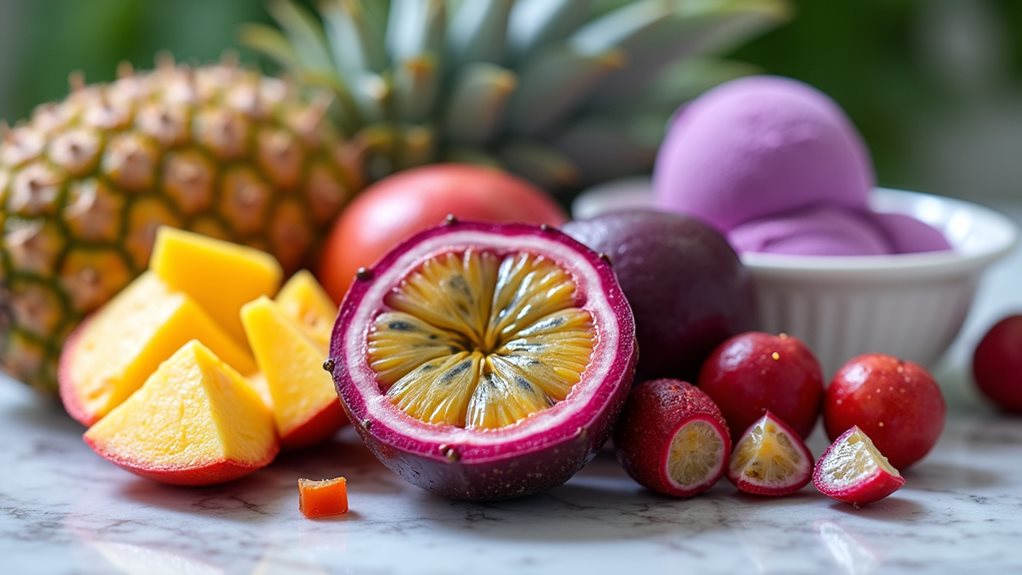
While ube's naturally sweet, nutty flavor stands confidently on its own, pairing it with fresh fruits can transform your purple yam creations into extraordinary culinary experiences.
The contrasting flavor contrasts and complementary fruit textures create depth that elevates traditional recipes to innovative masterpieces.
Try these fruit pairings to enhance your next ube creation:
- Combine mango and peach with ube in smoothies for a tropical experience that balances ube's earthiness with bright, summery notes.
- Add passion fruit (lilikoi) and pineapple to ube cakes for an exotic Hawaiian-inspired dessert with multidimensional sweetness.
- Incorporate pomegranate seeds into ube puddings for visual appeal and bursts of tartness that cut through the creamy richness.
Global Cuisine Inspirations for Ube Applications
As ube continues its global culinary ascent, innovative chefs and home cooks alike are discovering exciting ways to incorporate this vibrant purple tuber into diverse cultural traditions.
You'll find ube pastries reimagined as French croissants and Italian cannoli, while ube sauces transform ordinary pasta dishes into Instagram-worthy creations. The versatility of this Filipino staple shines when you explore international fusion—try incorporating ube into Japanese mochi, Mexican churros, or Indian kulfi.
Trending ube dishes include savory applications like ube gnocchi and creative ube garnishes for cocktails.
For your next culinary experiment, consider pairing ube with matcha in Japanese-inspired desserts or crafting ube snacks like purple churros dusted with cinnamon sugar.
These global interpretations honor ube's traditional roots while celebrating its place in contemporary cuisine.
Nutritional Benefits of Ube Flavor Combinations
Beyond its stunning purple hue and distinctive taste, ube offers remarkable nutritional benefits that can be enhanced through strategic flavor pairings.
When you combine ube with complementary ingredients, you'll create nutritional synergy that maximizes health advantages while delighting your palate.
- Pair ube with coconut milk to combine ube's fiber-rich profile with healthy fats, creating a satisfying treat that supports digestion and heart health.
- Add ube to smoothies with fruits and nuts to boost antioxidant intake, leveraging ube health properties like vitamin C and potassium.
- Incorporate ube into oatmeal or yogurt for a breakfast that delivers anthocyanins and flavonoids with anti-inflammatory benefits.
Frequently Asked Questions
Is Ube Safe for People With Specific Food Allergies?
Ube itself isn't a common allergen, but you'll need to watch for other ingredients in ube products. If you've got food allergies, check for dairy, wheat, or nuts that might trigger ube allergies or ube intolerance.
How Long Can Homemade Ube Products Be Safely Stored?
Fresh as morning dew, your homemade ube creations will maintain their magic for about 5 days in the fridge. For extended shelf life, freeze them—they'll keep for 3-6 months in airtight containers.
Can Ube Be Used in Savory Dishes Beyond Desserts?
Yes, you can definitely incorporate ube in savory cooking! Try adding it to pasta for a vibrant purple sauce or blend it into soups for earthy sweetness that pairs wonderfully with mushrooms and coconut milk.
Are There Vegan Alternatives for Traditional Ube-Butter Combinations?
You'll find plenty of vegan ube butter alternatives! Try coconut milk for rich ube halaya, vegan butter in mochi, or coconut butter for healthier treats. Plant-based alternatives like these create innovative, dairy-free ube delights.
Does Ube Powder Provide the Same Flavor as Fresh Ube?
Like a watercolor versus oil painting, ube powder offers a lighter sketch of flavor compared to fresh ube's vibrant portrait. You'll notice ube powder's muted sweetness and subtler earthiness in your culinary innovations.
Final Thoughts
You've now witnessed ube's remarkable versatility, from traditional Filipino pairings to innovative global applications. While culinary experts might have you believe that coconut and vanilla are ube's only worthy companions, you've discovered how this humble purple tuber defies such limitations. Next time someone insists on conventional flavor combinations, smile knowingly—you're part of the underground ube revolution, armed with combinations that would make any food purist delightfully uncomfortable.

